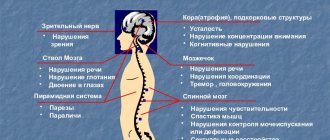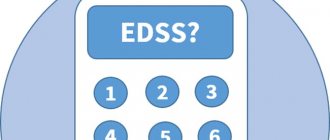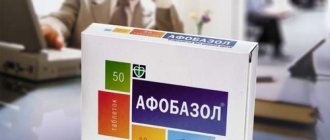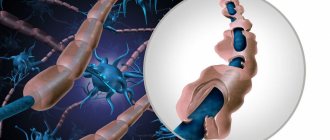Multiple sclerosis (MS) first became known to humanity as a separate nosology in 1868. Despite the fact that people have been dealing with this disease for such a long period, the causes of its occurrence and methods of treatment are still completely unknown (not a single case of multiple sclerosis has been completely cured).
Only since the end of the twentieth century have new drugs that modify the course of multiple sclerosis (DMMS) become available to patients, which, in certain types of the disease, can stop its development and preserve the patient’s ability to work.
Every patient diagnosed with MS has a question: what are the pros and cons of using DMTs?
What are PITRS
Since MS is an autoimmune disease, it involves a malfunction of the immune system.
Scientists have come to the conclusion that the basis of treatment should include immunomodulatory agents, the principle of which is based on the influence on the activity of the immune system. The DMT group includes medications containing the following active ingredients:
- interferon beta-1a;
- interferon beta-1b;
- glatiramer acetate;
- teriflunamide;
- fingolimod;
- mitoxantrone;
- natalizumab.
The principle of choosing DMTs for treatment
DMT drugs for multiple sclerosis are prescribed based on the following factors:
- stage of the disease;
- severity of the course;
- patient consent;
- the presence of exacerbations;
- patient's age.
Early therapy is considered to be the initiation of medications after diagnosis. The remitting course of the disease is the presence of at least two periods of exacerbations over the past two years, if the dynamics on MRI are negative. Secondary progressive MS shows activity on MRI examination. The severity of the patient's condition to prescribe DMT should not exceed 6.5 points on the EDSS scale (if no previous treatment has been carried out).
The presence of complications and their progression also influence the choice of drug. In the relapsing form, Glatiramer acetate, Interferon beta-1b and beta-1a are used subcutaneously and intramuscularly. Secondarily progressive MS with complications is treated with Interferon beta-1b, beta-1a subcutaneously. Biological products (original and generic) may differ in recommendations for use, including age restrictions. DMTRS are prescribed from the age of 12 years. If the patient is under 12 years of age, the use of the drug is approved by a medical commission taking into account the results of clinical studies and informing the child’s parents/guardians.
Studies confirming the effectiveness of immunomodulators
The first PMTRS was registered in 1993 and since then there have been significant breakthroughs in the treatment of the disease. New and highly effective medicines belonging to the DMT group are constantly being created. The wide range of drugs currently available has proven effectiveness, as confirmed by many international studies.
Studies of the safety and effectiveness of immunomodulators in the treatment of MS, including comparative studies, have been conducted since the late 1990s.
Key studies:
- After the FDA (Food and Drug Administration) approved betaferon (interferon beta-1b) in 1993 as a drug for the treatment of relapsing-remitting multiple sclerosis, a study was conducted over 16 years in eleven treatment centers in the United States to prove the effectiveness and safety of the use of this active substance in the treatment of relapsing-remitting type diseases. Throughout the study, there was a slowdown in disease progression and a decrease in the frequency of exacerbations.
- The BENEFIT (BEtaferon in Newly Emerging MS For Initial Treatment) study proved the appropriateness of prescribing betaferon after clinical isolated syndrome.
- When using the drug for two years, the risk of developing multiple sclerosis is two times lower. Modern medicine recommends prescribing betaferon after the first episode of the disease.
- A 2004 study at the Russian Medical University in Moscow, within the framework of a doctoral dissertation on the topic “Study of quality of life indicators and pharmacoeconomic analysis in patients with multiple sclerosis,” proved that the use of DMTs with such active ingredients as glatiramer acetate, interferon beta-1a, interferon beta- 1b prevents disability per year by an average of 45%.
- Pharmacogenetic studies based on pharmacogenetic analysis have received a new direction. In their course, the effectiveness of drugs is studied depending on the genetic characteristics of the patients. By identifying genes that influence the effectiveness of immunomodulators, scientists will be able to predict not only the clinical effects of an individually selected drug, but also predict possible adverse reactions. The result of the research will be the possibility of treating MS, taking into account individual characteristics.
However, it should be noted that no drug has yet provided complete recovery from the disease.
For what purpose are PITRS used?
Drug therapy with drugs that modify the course of multiple sclerosis is used for the following purposes:
- reduction of lesions detected during MRI, brain and spinal cord injuries;
- reduction in the frequency of exacerbations;
- alleviation of the severity of the disease;
- preservation of efficiency, self-service capabilities;
- delaying possible disability.
MS exacerbations are defined as new or worsening existing symptoms lasting more than 24 hours if they occur less than a month after the last remission. Treatment with drugs is most effective in the early stages, when disorders have not yet led to irreversible consequences. However, even with a long course of the disease, patients after a course of treatment experience an improvement in vital signs. The earlier treatment is started, the better results can be expected.
The prescription of DMT drugs is within the competence of a neurologist. As a rule, the course of therapy is carried out repeatedly. While taking the drug, the doctor monitors the course of sclerosis, controlling symptoms. Sometimes it becomes necessary to adjust treatment. The effectiveness of therapy is observed after continuous use of drugs for six months to a year.
Mechanism of action
Despite the general focus, the mechanisms of action of various drugs differ:
- Interferons beta have a general, nonspecific immunomodulatory effect.
- Glatiramer acetate has a specific effect: competitive replacement of myelin antigens at the sites of connection with molecules of the major histocompatibility complex. The result of the drug is inhibition of T1 lymphocytes and activation of T2 lymphocytes, the latter have a positive effect on the course of the disease and contribute to anti-inflammatory and neuroprotective processes.
- Teriflunomide inhibits the division of cells of the immune system, leading to a decrease in the number of circulating B and T cells. The drug has immunomodulatory and anti-inflammatory properties.
- Natalizumab is a recombinant monoclonal antibody against adhesion molecules. The action is aimed at slowing down the passage of lymphocytes through the blood-brain barrier, suppressing the activity of T-lymphocytes in areas of axonal damage and reducing the likelihood of recurrent inflammation in damaged areas.
- The action of Fingolimod is based on innovation: blocking sphingosine-phosphate receptors of lymphocytes, as a result of which lymphocytes do not leave the lymph nodes and, accordingly, the number of auto-aggressive T cells in the blood decreases; the drug also penetrates the brain and affects sphingosine-1-phosphate receptors of glial cells and neurons.
- Mitoxantrone creates bonds with nuclear DNA. The mechanism of its action is not fully understood. It is known that the drug has a cytotoxic effect on both proliferating and non-proliferating human cells, that is, its effect is not related to the phase of the cell cycle
PITRS first and second lines
As a rule, treatment of multiple sclerosis begins with first-line DMT:
In the initial stage of treatment the following is used:
- interferon beta-1a – subcutaneously (three times a week);
- interferon beta-1a – used intramuscularly (once a week);
- interferon beta-1b – subcutaneously (every other day);
- glatiramer acetate – subcutaneously (every day);
- teriflunamide tablets (every day).
The effect of first-line drugs has been studied better than the second. Their effectiveness is high, but in some cases insufficient, which gives the doctor reasons to prescribe second-line DMTs:
- Natalizumab – intravenous drip (once every 4 weeks);
- Fingolimod – tablets (daily).
To treat patients with high activity of relapsing multiple sclerosis, accompanied by rapid disability, when it is impossible to use alternative therapeutic agents, antineoplastic drugs are used (for example, Mitoxantrone - intravenous drip once every three months).
The main side effect of first-line DMTs is mental disorders manifested by depressive states. It is also possible that the drugs have a negative effect on the circulatory, hepatobiliary, and central nervous systems.
Second-line medications are characterized by several severe side effects - damage to the heart muscle, heart rhythm disturbances, and the appearance of progressive multifocal leukodystrophy.
When choosing second-line drugs, the doctor resorts to a careful analysis of the possible risks associated with their prescription. The patient is advised to undergo regular medical supervision.
Innovative approaches to the treatment of secondary progressive multiple sclerosis
Professor of the Department of Neurology spoke about one of the most socially significant diseases of the nervous system, which occupies a leading place (together with injuries and rheumatological diseases) in the list of causes leading to complete disability at a young working age, and which has become a serious burden for the budget of the health care system of a number of countries. Neurosurgery and Medical Genetics Russian National Research Medical University named after. N.I. Pirogova, neurologist of the highest category of the interdistrict department of multiple sclerosis of City Clinical Hospital No. 24 (Moscow) Natalya Khachanova .
— More recently, MS was considered a rare disease, but what are the statistics for Russia today?
— Let me clarify: rare are orphan diseases (less than 10 cases per 100 thousand population), multiple sclerosis does not belong to this category. In Russia, its prevalence ranges from 10 to 50 cases per 100 thousand population.
Compared to other non-orphan nosologies, there are, of course, noticeably fewer patients with MS, but their number both in our country and in the world has been steadily growing recently, which causes concern among neurologists and doctors of other specialties. According to The Atlas of MS, published by the Multiple Sclerosis International Federation (MSIF), in 2013, about 2.3 million people worldwide suffered from multiple sclerosis; since 2008, the global prevalence of MS has increased by 10 % - from 30 to 33 cases per 100 thousand population. Today, the number of MS patients has reached 2.8 million. The growth, according to experts, is associated both with improved diagnostics and increased possibilities of pathogenetic and symptomatic therapy, and with a true increase in incidence for “still unclear reasons.”
Data for Russia vary somewhat. Thus, the Ministry of Health reports about 85.2 thousand people diagnosed with MS in 2021 (in 2021 – 80.5 thousand). But in the literature devoted to our problems, other information appears: more than 100 thousand, closer to 150 thousand people. I can’t say on what these calculations are based, probably based on 50 cases per 100 thousand population. Perhaps these differences are due to the fact that we actually started recording patients for a specific nosology relatively recently. The Federal Register of MS Patients is constantly updated, but, according to most doctors and researchers, it still contains incomplete information.
When the register was introduced, a number of patients were not indicated for expensive drugs, and, accordingly, personalized information on them was not submitted to the Ministry of Health. Now the situation is somewhat different: information is submitted for any newly identified patient (which, by the way, among other things, explains the statistical growth). There are still a number of patients who are “missed” by the registry. For example, people who refuse classical medical care, other categories (military personnel) who remain outside the scope of the specialists who provide information.
— Neurologists talk about MS as a multifactorial disease. Where does genetics fit into these factors?
“Indeed, several components fit into a puzzle, and a particular patient develops a disease. Among the factors, genetics is also considered, more precisely, a hereditary predisposition, probably not specifically to multiple sclerosis, but to a possible immunological failure. In our practice, there are cases of familial MS.
Among the “pieces” of this puzzle, we also consider environmental factors, and there is a huge field for search here. This includes vitamin D deficiency, low insolation, smoking, and individual nutritional factors. The role of viruses, especially frequent infections in childhood, cannot be ruled out. One way or another, we are talking about a combination of factors.
To this it should be added that there must also be some kind of trigger element, a trigger, which ultimately triggers the entire mechanism that provokes the body’s immunity to show aggression towards its own nervous tissue. Currently, a group of herpes viruses is being intensively studied as a trigger, in particular the Epstein-Barr virus. This is due to the fact that more than 90% of our patients are carriers of this virus (many suffered from infectious mononucleosis in childhood). It may be too early to talk about it as at least one of the etiological factors, but as a trigger factor, there are definitely grounds.
— How far has neurology advanced in the early diagnosis of the disease? What forms of MS do doctors most often encounter?
- I've made a lot of progress. But note, not through the use of new methods. They basically remained the same: clinical examination and clinical picture of the disease, examination by a neurologist and MRI, examination of cerebrospinal fluid. The diagnostic criteria themselves have changed. Now they allow many patients to be diagnosed already at the onset of the disease, and most importantly, thanks to only one MRI examination. Although, of course, some patients have to be monitored over time, not limited to just one study (for people with primary progressive MS, confirmation is required).
— And yet the diagnosis of multiple sclerosis is actually difficult?
— MS is considered a “chameleon” of neurology. Under its mask, completely different diseases can be hidden. Therefore, we must additionally conduct a broad differential search... The diagnosis of MS is made as a last resort. But, I repeat, in any case, modern criteria make it possible to make a diagnosis much faster.
Now about the forms of RS. About 10–15% of patients at the time of treatment will have primary progressive multiple sclerosis (PPMS), 85% or more will have a relapsing-remitting form. But this is if we are talking about a debut patient. Over time, the pattern of disease progression may differ: patients who initially suffered from relapsing-remitting MS may move into the secondary progressive multiple sclerosis (SPMS) group.
— Is SPMS an inevitable stage of the disease?
- Yes. Any patient who is diagnosed with relapsing-remitting multiple sclerosis at the onset will sooner or later be faced with a secondary progressive course. It is the matter of time.
In the remitting phase, the patient occasionally experiences exacerbations, which can lead to temporary disability. From exacerbation to exacerbation, neurological deficit accumulates. When the patient enters the SPMS phase, the very concept of disease progression changes: there are no exacerbations, but the neurological deficit is steadily increasing. A person notices that he begins to walk shorter distances, he needs to stop more often to rest... then there is a need to purchase walking aids, then a wheelchair. But the main thing is that in order for the disease to progress, exacerbations are no longer necessary, this process proceeds by itself.
— Can the number of exacerbations in MS be predicted?
- No impossible. Therefore, there is therapy, the task of which is to prevent the development of exacerbations. And it should be prescribed as early as possible. The ideal effect of treatment is the absence of exacerbations, therefore, there is no neurological deficit and its progression. If the MRI does not show new lesions, the disease is frozen at the stage at which we encountered it, that is, we did not reverse it, but stopped it.
There is an international observation indicating a “natural history of multiple sclerosis.” It follows that with age and the duration of the disease, the aggressiveness of the immune system begins to decrease, so even in a patient without therapy, the frequency of exacerbations will decrease over the years. Although in clinical practice we often encounter another trend: without specific treatment, the rate of disease progression is higher and the path to a wheelchair is shorter.
— Progress in the treatment of MS over the past few decades has been recognized by WHO as one of the highest achievements of modern medicine. How has therapy changed during this time?
— The changes have taken place colossal. Imagine, in 1996 we had a choice of only two drugs, in 2001 another one was added to them (two interferon and one non-interferon), and today we have a line of 15 drugs! It became possible to treat a patient with any type of MS, which was not possible before. Plus, new molecules are constantly being developed.
I consider the existence of the “14 high-cost nosologies” program, which provides our patients with the necessary drugs, to be a great achievement of Russia. It includes a significant portion of drugs for the treatment of MS, and those not included are included in the List of Vital and Essential Drugs. Thus, in any case, our patient has the right to free medication.
— Are there differences in the tactics of managing patients with MS here and abroad?
- No. Firstly, we are guided by the best experience of foreign colleagues, the recommendations of the European Committee for Research and Treatment of Multiple Sclerosis and the European Academy of Neurology for the treatment of patients with multiple sclerosis - we are not reinventing the wheel. Secondly, instructions for the medical use of the drug are mandatory in each country. Therefore, any tactical changes in approaches to therapy are limited by this instruction, and if its provisions are violated, the pharmaceutical company that manufactures the drug disclaims responsibility for the risks.
— What are the prospects for drug therapy in patients with SPMS, are there drugs that help maintain them?
— Patients with SPMS according to the modern classification are divided into four options. This may be a patient who is active, that is, despite the secondary progression of the disease, he continues to have exacerbations, but there is no progression of disability. The second option is that while activity remains, MRI data show negative dynamics, new areas of damage to the nervous tissue appear, due to which disability increases. The third is when the patient does not have exacerbations, but the condition worsens. And the fourth option is no activity and no progression, that is, MS went into secondary progression, at some point accumulated a new deficit, and then stopped.
This international division of phenotypes into four options implies: the first three groups (activity + progression; activity without progression; without activity, but with progress) require therapy, because the disease clearly progresses and worsens the patient’s quality of life. For these patients, active therapy to combat exacerbations was available until the end of last year. But for patients who progress without activity, there were no drugs. We tried using one chemotherapy drug, it helped to some extent, but was too toxic, especially with long-term therapy. A new drug registered by the Russian Ministry of Health in 2021 solves these problems.
A registration study of this drug showed that it can be used in any patient diagnosed with secondary progressive multiple sclerosis. In my opinion, this expands our capabilities and somewhat adjusts the tasks: now we must identify the transition to SPMS as early as possible and change treatment tactics (if the patient has no contraindications).
— What does the success of MS therapy depend on? What advice can you give to your colleagues and their patients?
— Criteria for success? There will probably be several of them. First of all, timely diagnosis. Because if a patient has not sought help for 15 years, then over these years the neurological deficit will be completely different than that of a patient at the initial stage of the disease. In our case, the timeliness of diagnosis is closely related to the activity of the immune system: the closer to the onset we are, the higher the immunological aggression. Accordingly, the greater the opportunity to suppress this aggression as early as possible, preventing it from destroying more and more significant structures.
The later we make a diagnosis, the greater the likelihood that many damage processes have already taken place, and nothing can be reversed with the available therapy. And the immune system itself may no longer be at that stage, and therefore is controlled less effectively. The importance of timely diagnosis cannot be overestimated. Obviously, not only the patient, but also the therapist and general practitioner treating him should be of a certain alertness.
Next... During the first years, when MS is most aggressive, you should be extremely attentive to patients (especially relapsing-remitting ones) and the degree of disease activity. Moreover, modern therapeutic capabilities make it possible to do this in a differentiated manner: for patients with high activity, there is a line of drugs that are more aggressive, stronger, and more effective. This is a very important period that does not allow therapeutic inertia (when the doctor is in no hurry to apply treatment tactics or change the treatment plan).
The third important factor is the availability of necessary medications. We must teach the patient, as in the West, to share risks with the doctor. He must take an active position in choosing treatment and, most importantly, in following recommendations. Unfortunately, we often encounter the fact that patients do not understand the degree of their responsibility and participation in treatment.
Therapeutic effect, indications
The goal of PED therapy is to cause the following changes in the patient’s body:
- reduce foci of damage to the central nervous system (brain and spinal cord) identified by MRI;
- reduce the number of exacerbations;
- alleviate the course of the disease;
- maintain efficiency and ability to self-care;
- delay disability;
First-line drugs are prescribed if the following symptoms are present:
- relapsing-remitting type of multiple sclerosis;
- age criterion: 18 - 50 years;
- the severity of the clinical picture does not exceed 5.5 points on the EDSS scale;
- over the previous two years, at least 2 exacerbations with a gap of 30 days or more between them and a stable neurological condition.
Indications for prescribing 2 line DMTRS:
- primary aggressive course of multiple sclerosis;
- insufficient effectiveness of first-line drugs.
In case of continuous deterioration of autoimmune processes against the background of specific treatment, antineoplastic agents (cyclophosphamide and mitoxantrone) can be used as third-line drugs.
In extreme cases, autologous bone marrow transplantation is used.
PED therapy allows patients with multiple sclerosis to live a full life
On the eve of the International Day of Multiple Sclerosis, the head of the specialized medical care department of polyclinic No. 5 of branch No. 2 of the City Hospital No. 1 named after. N.I. Pirogova”, chief freelance specialist neurologist, candidate of medical sciences Elena Tokareva
told a correspondent of the Center for Public Health and Medical Prevention about the disease, the diagnosis of multiple sclerosis in Sevastopol, the number of cases and the possibilities of its treatment.
By multiple sclerosis, ordinary people often understand memory impairment in old age. But that's not true.
How does this disease manifest itself and why is it dangerous?
Multiple sclerosis is a chronic, progressive autoimmune disease that affects the myelin sheath of nerve fibers in the brain and spinal cord.
The disease received its name because of its distinctive pathoanatomical feature - the presence of sclerosis foci scattered throughout the central nervous system without a specific localization, that is, the replacement of normal nervous tissue with connective tissue.
The morphological feature of the disease is the formation of so-called multiple sclerosis plaques - foci of destruction of the white matter of the brain and spinal cord.
This is a disease of the young. The peak incidence occurs during the most active period of a person’s life – 20-40 years. However, the disease can also develop in children.
Symptoms of multiple sclerosis debut in different ways - depending on the location of the lesions in the brain and spinal cord, its degree and disturbances in the conduction of impulses. Multiple sclerosis may be indicated by paresis and paralysis - partial or complete lack of movement in the limbs, muscle hypertonicity, obsessive and involuntary movements, and visual impairment.
The disease causes sensory disturbances with tingling and numbness in the fingers and toes, a feeling of unsteadiness of the ground under your feet, “wobbly” legs and other problems with movement, fatigue, fatigue.
What causes this disease?
Most often, multiple sclerosis occurs in residents of Northern Europe and Canada. The frequency of cases increases to the north.
This is due to sunlight. Under the influence of ultraviolet light, vitamin D is synthesized in the skin, which is then converted into its active form - calcitriol. Low vitamin D levels increase the likelihood of developing multiple sclerosis.
However, this does not mean that taking vitamin D regularly will prevent the disease. Any medications should be taken only after the recommendation of the attending physician.
However, patients with multiple sclerosis who received this vitamin as a dietary supplement experienced improvement in their disease. Various viruses can also increase the risk of developing the disease, in particular, the Epstein-Barr virus, cytomegalovirus, and some retro- and polyomaviruses. Smoking also increases the risk of the disease.
How is multiple sclerosis diagnosed in Sevastopol?
The most important way is to conduct an MRI, where we see foci of inflammation, foci of demyelination on sections in certain programs.
We can only rely on the clinical picture and MRI, as well as our own experience when making this diagnosis.
In Sevastopol, about 350 people suffer from multiple sclerosis, of which 320 people receive therapy - DMT drugs, which affect the course of the disease and create a stable quality of life
. Our patients receive medications under a special program 14VZN. The state fully provides them with all necessary medicines.
What results can be achieved in the treatment of multiple sclerosis?
Multiple sclerosis requires lifelong treatment. Today, the treatment effect is achieved through drugs that modify the course of multiple sclerosis, abbreviated as MSD. Their actions are aimed at creating stable and long-term remission in patients.
Thanks to DMT therapy, it is possible to reduce the number of exacerbations and preserve healthy nerve tissue. Each exacerbation causes damage to nerve tissue, which lasts for the patient for life.
It is almost impossible to restore this damaged tissue, so all patients must be committed to treatment and must constantly contact the “multiple sclerosis” office or their neurologist at their place of residence.
Constant monitoring and adherence to therapy are the key to active longevity and complete control over the disease.
Interviewed by A. Pribilova
When medications are not used
The following contraindications are common to all PEDs:
- hypersensitivity to the active substance or auxiliary components of the drug;
- decompensated or severe forms of liver disease;
- pregnancy, breastfeeding.
Additional contraindications for interferons:
- primary progressive forms of MS;
- the presence of severe depression, thoughts of suicide, mental disorders;
- heart disease in severe forms.
Additional contraindications for glatiramer acetate:
- panic attacks.
Additional contraindications for teriflunamide:
- severe immunodeficiency states;
- hematopoietic pathologies;
- renal decompensation;
- acute infectious diseases in severe forms;
- a sharp decrease in protein in the blood;
- age up to 18 years.
Typical additional contraindications for second-line DMTs:
- immunodeficiency states;
- the possibility of infection of the patient with opportunistic microorganisms;
- cancer tumors, except basal cell carcinoma;
- progressive multifocal leukoencephalopathy;
- simultaneous use of first-line DMTs;
- childhood and adolescence.
You should know that the prescription of DMTs to children under 12 years of age must be approved by a medical commission; when choosing drugs, the results of diagnostic studies must be taken into account. Parents/legal guardians are informed of the possible risks and consent to prescribing medications to the child is obtained.
Practical application experience
According to the results of one of the scientific studies, “Patient Assessment of the Effectiveness of Multiple Sclerosis Therapy,” the results of which were published in 2021, the main indicators of the effectiveness of treatment are the absence of an aggravated clinical picture and progression of disorders of the nervous system.
At the same time, the subjective opinion of patients about the effectiveness of treatment was found more often than the effectiveness was confirmed by diagnostic methods. Over three years, the studied patients noted in 57% of cases a decrease in the number of exacerbations from 1 to 3 and in 24% of cases the absence of an aggravated clinical picture. All of these people find the therapy effective.
The study established a threshold for low treatment effectiveness: more than three episodes of exacerbation of the clinical picture in three years.
The study also found that subjective assessments of the positive effect of MS treatment directly depend on the relationship with the attending physician. Patients who indicated that their vision of the effect of treatment coincided with the goals set by the attending physician generally rated the results of therapy highly. Treatment was more often considered ineffective by those patients whose opinions differed from the goals of the doctors.
Permitted PITRS in Russia








